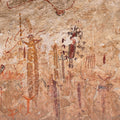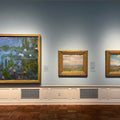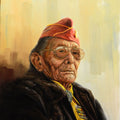Denver Museums Display Two Widely Varied Viewpoints of Western Art
By Chadd Scott on
Charles Marion Russell defines the tradition of Western art. He doesn’t follow the tradition; he established the tradition. Exquisitely rendered oil paintings, sketches and bronze sculptures of horses, cowboys, ranchers, gunfights, and Native Americans.
In November of 1921, C.M. Russell (1864-1926) and his wife Nancy (1878-1940) made their only known trip to Denver from their home in Montana. They were being hosted by the legendary Brown Palace Hotel downtown for a two-week showcase of Russell’s artwork.

'The Russells in Denver, 1921' exhibition installation view at Denver Art Museum | Photo by Chadd Scott
In an ongoing exhibition at the Denver Art Museum, a half mile from the Brown Palace Hotel, “The Russells in Denver, 1921” amazingly places nine paintings and seven painted plaster sculptures from that initial presentation of Russell’s work back on view in the Mile High City 102 years later.
If Russell exemplifies what has come to be considered Western art over the past century, what’s on view now at the Museum of Contemporary Art Denver turns those notions on their head. Not a rejection, consider it an expansion.
All three floors of the MCA are given over to “Cowboy” through February 18, 2024, an exhibition shifting perceptions about this central figure in the story and imagination of Western art, the West, and all America. No character has held more cultural influence in shaping each.
The mythologized cowboy of the West, the cowboy that has become a defacto stand-in for America across the globe, and the cowboy Russell depicted, were the same.
Rough and tumble. A rugged individual. The strong, silent type. Antithetical to city life. Happy to work long hours in grueling conditions for little pay, and equally happy to solve his problems with fists and firearms.
A man’s man – whatever that means.
White. Male. Macho. Heterosexual.
The 27 international artists with work on view at the MCA Denver portray a vastly different version of the cowboy. A Black cowboy. An Indian cowboy. A global cowboy. A queer cowboy. A sensitive cowboy. A city cowboy.
The Denver Art Museum’s Russell exhibition displayed alongside its best-in-class collection of Western art – “traditional” Western art, derived from Russell Western art – on view simultaneously with what many Western art devotees will consider radical contemporary interpretations of Western art at the MCA a mile down the road offers a delicious contrast for anyone open to challenging their perceptions.
The Cowboy as Construct
“Since the 19th century, the myth of the cowboy has been adopted in myriad forms as a profitable, attractive, and compelling tool for commercialization, political gain, the reinforcement of racial and gender stereotypes, and as an idealized justification for American land appropriation and ambition,” wall text at the MCA Denver introducing “Cowboy” reads.
The reality of the cowboy – laborer, ranch hand, African American, Mexican – was long ago subsumed by the myth of the cowboy. How that figure was plucked from reality and placed into a cinematic and literary spectacle is a flatly modern act of creativity and erasure. The transformation was achieved through countless dime novels and Hollywood movies. And Western paintings.

C.M. Russell, 'A Tight Dally and a Loose Latigo' (1920); collection of Amon Carter Museum on view at Denver Art Museum | Photo by Chadd Scott
The popularity of C.M. Russell’s artwork – and Remington’s and others – in no small measure contributed to the flattening out of the cowboy.
A grandiose, spurs jangling, guns blazing, hard drinking, womanizing, unapologetic, walking, talking advertisement for toxic masculinity.
A multi-faceted truth transformed into a fictionalized, homogenized, flag-waving, John Wayne version ready for packaging and distribution across the country and world. This creation eventually came to be accepted as authentic. It wasn’t.
The cowboy today cuts as both an invention and a historical and contemporary reality. The same could be said of the West and the entire nation.
That doesn’t make Russell’s version of the cowboy, of the West, of America, wrong, but it is incomplete.
The “Cowboy” artists at the MCA Denver aim to fill out the picture, bring the character into a contemporary context, and reveal its many sides lost to the stereotype.
Expanding Visions of Western Art
The version of the cowboy and the West and Western art at the MCA needn’t replace Russell’s version at DAM. This is not an “either/or.” Plenty enough room exists for both; an expanded version featuring Black, Indigenous and Latino perspectives on equal footing with Russell’s and Remington’s and Dixon’s.
The work more than holds its own as best demonstrated by Otis Kwame Quaicoe (1988), a painter from Ghana living in Portland with a pair of paintings on view in “Cowboy” even Russell would admire. The TV and movie cowboy reached all the way across the globe and captivated Quaicoe as a boy in west Africa.
“Engaging with the history of Black cowboys and Black rodeo culture, his paintings chafe against the narrow tropes with which the cowboy has been depicted and promoted through popular culture,” MCA wall text accompanying his masterful Rodeo Boys (2022) states.
Notice the animation in the two men’s faces. The deft paint handling achieving the ruffle and wrinkle of their shirts. The composition. The drama – what has caught the attention of the figure on the left?

Otis Kwame Quaicoe, 'Rodeo Boys,' (2022) | Photo by Chadd Scott
The painting could – and should – hang side-by-side with the best of “traditional” Western art. There’s nothing in the rules saying an African can’t paint Western art as good as a Montanan. Remington was no Westerner.
Western art as a genre can only gain from the inclusion and invitation of more voices, of greater diversity. No relevant artform can afford to be stagnant. Nothing thrives through exclusion.
There was a time when female artists weren’t welcomed into the tent of Western art. They still aren’t to the degree they should be. At every turn, their presence uplifts the category.
Latino artists. Asian artists. Black artists will all do the same.
They have talent and stories of the West to share as well.
Western art collectors and curators and museum directors and gallery owners and critics and writers are well advised to open doors for them. You’ll be glad you did. I’m glad I have.
The richness of the West, of America, of the cowboy, of Western art rests not in one narrow interpretation, but in perceiving it through as wide and open a lens as possible. A lens including Otis Kwame Quaicoe. A lens which doesn’t forget C.M. Russell.
Not C.M. Russell vs. Otis Kwame Quaicoe. C.M. Russell x Otis Kwame Quaicoe.
A lens that can see and appreciate them both equally, and see them primarily for what they have in common, not what they don’t.



